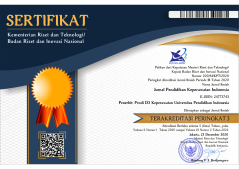Using Thermography Infrared to Detect Diabetic Foot Ulcers in Asia Pacific Countries: Scoping Review
Abstract
Introduction: Diabetes Mellitus (DM) is a growing global health concern, particularly in Indonesia, where the prevalence is projected to rise significantly. Diabetic Foot Ulcer (DFU) is a severe complication of DM that escalates the risk of amputations. Early detection of DFUs plays a crucial role in preventing associated complications Objective: This review aimed to assess the efficacy of infrared thermography in detecting DFUs in the Asia-Pacific region. Methods: A scoping review methodology adhering to PRISMA guidelines was employed. Databases were searched from 2011-2021. PICO strategy used keyword Diabetic foot ulcer, Skin ulcer, Leg ulcer, Foot ulcer, Diabetic neuropathic, Thermography, Temperature mapping, and Detection from PubMed, Scopus, Google Scholar, and Science Direct. Quality of article assessed by JBI. Results: Four (4) studies meeting the inclusion criteria were identified, primarily cross-sectional in design. The results indicated promising sensitivity and specificity of infrared thermography in detecting DFUs among DM patients. The technology's ability to capture thermal images revealing temperature variations associated with tissue inflammation, a common DFU indicator, underscores its efficacy. This non-invasive technique allows for early detection and monitoring of DFUs, facilitating timely interventions and improving patient outcomes. Additionally, infrared thermography provides a quantitative and objective assessment of tissue health, complementing traditional visual inspection and palpation methods. Its effectiveness lies in detecting subtle skin temperature changes, aiding in early identification and management of DFUs before they progress to more severe stages. Conclusion: Infrared thermography shows significant potential in detecting DFUs early, which is vital for effective management and prevention of severe complications. Despite the promising results, broader and more rigorous studies are necessary to validate these findings across different populations and healthcare settings. Further research across diverse settings and study designs is essential to reinforce these findings.
Keywords
Full Text:
PDFReferences
Adam, M., Ng, E. Y. K., Oh, S. L., Heng, M. L., Hagiwara, Y., Tan, J. H., Tong, J. W. K., & Acharya, U. R. (2018). Automated detection of diabetic foot with and without neuropathy using double density-dual tree-complex wavelet transform on foot thermograms. Infrared Physics and Technology, 92(April), 270–279.
Aliahmad, B., Tint, A. N., Poosapadi Arjunan, S., Rani, P., Kumar, D. K., Miller, J., Zajac, J. D., Wang, G., & Ekinci, E. I. (2019). Is Thermal Imaging a Useful Predictor of the Healing Status of Diabetes-Related Foot Ulcers? A Pilot Study. Journal of Diabetes Science and Technology, 13(3), 561–567.
Bandalakunta Gururajarao, S., Venkatappa, U., Shivaram, J. M., Sikkandar, M. Y., & Al Amoudi, A. (2019). Infrared Thermography and Soft Computing for Diabetic Foot Assessment. Machine Learning in Bio-Signal Analysis and Diagnostic Imaging, January, 73–97.
Bus, S. A., Stegge, W. B. De, Baal, J. G. Van, Busch-, T. E., Nollet, F., & Netten, J. J. Van. (2021). Effectiveness of at- home skin temperature monitoring in reducing the incidence of foot ulcer recurrence in people with diabetes : a multicenter randomized controlled trial ( DIATEMP ). 1–11.
Cho, N. H., Shaw, J. E., Karuranga, S., Huang, Y., Rocha, J. D., Ohlrogge, A. W., & Malanda, B. (2018). IDF Diabetes Atlas : Global estimates of diabetes prevalence for 2017 and projections for 2045. Diabetes Research and Clinical Practice, 138, 271–281.
Doremalen, R F M Van, Netten, J. J. Van, & Baal, J. G. Van. (2019). Validation of low-cost smartphone-based thermal camera for diabetic foot assessment. 9, 0–7.
Global Report on Diabetes. (2016). In World Health Organization. https://www.who.int/publications/i/item/9789241565257, accessed 21 March 2024
Ilo, A., Romsi, P., & Mäkelä, J. (2020). Infrared Thermography and Vascular Disorders in Diabetic Feet. Journal of Diabetes Science and Technology, 14(1), 28–36.
Liu, C., van Netten, J. J., van Baal, J. G., Bus, S. A., & van der Heijden, F. (2015). Automatic detection of diabetic foot complications with infrared thermography by asymmetric analysis. Journal of Biomedical Optics, 20(2), 026003.
Maddah, E., & Beigzadeh, B. (2020). Use of a smartphone thermometer to monitor thermal conductivity changes in diabetic foot ulcers: A pilot study. Journal of Wound Care, 29(1), 61–66.
Mamédio, C., Investigación, P. D. E., Búsqueda, Y. L. A., & Evidências, D. E. P. E. B. D. E. (2007). THE PICO STRATEGY FOR THE RESEARCH QUESTION CONSTRUCTION AND EVIDENCE SEARCH. 15(3), 508–511.
Moher, D., Liberati, A., Tetzlaff, J., Altman, D. G., & Group, P. (2009). & reporting Preferred reporting items for systematic reviews and meta-analyses : the PRISMA statement. 339(august). 1-10.
Moola, S., Munn, Z., Tufanaru, C., Aromataris, E., Sears, K., & Sfetcu, R Currie M, Qureshi R, Mattis P, Lisy K, M. P.-F. (2017). Checklist for analytical cross sectional studies. Joanna Briggs Institute Reviewer’s Manual, 1–7.
Moxey, P. W., Gogalniceanu, P., Hinchliffe, R. J., Loftus, I. M., Jones, K. J., Thompson, M. M., & Holt, P. J. (2011). Lower extremity amputations - a review of global variability in incidence. Diabetic Medicine, 28(10), 1144–1153.
Nagase, T., Sanada, H., Takehara, K., Oe, M., Iizaka, S., Ohashi, Y., Oba, M., Kadowaki, T., & Nakagami, G. (2011). Variations of plantar thermographic patterns in normal controls and non-ulcer diabetic patients: Novel classification using angiosome concept. Journal of Plastic, Reconstructive and Aesthetic Surgery, 64(7), 860–866.
Petrova, N. L., Whittam, A., Macdonald, A., Ainarkar, S., Donaldson, A. N., Bevans, J., Allen, J., Plassmann, P., Kluwe, B., Ring, F., Rogers, L., Simpson, R., Machin, G., & Edmonds, M. E. (2018). Reliability of a novel thermal imaging system for temperature assessment of healthy feet. Journal of Foot and Ankle Research, 11(22), 1–6.
van Doremalen, Rob F.M., van Netten, J. J., van Baal, J. G., Vollenbroek-Hutten, M. M. R., & van der Heijden, F. (2020). Infrared 3D Thermography for Inflammation Detection in Diabetic Foot Disease: A Proof of Concept. Journal of Diabetes Science and Technology, 14(1), 46–54.
Van Netten, J. J., Van Baal, J. G., Liu, C., Van Der Heijden, F., & Bus, S. A. (2013). Infrared thermal imaging for automated detection of diabetic foot complications. Journal of Diabetes Science and Technology, 7(5), 1122–1129.
Zhang, P., Lu, J., Jing, Y., Tang, S., Zhu, D., & Bi, Y. (2017). Global epidemiology of diabetic foot ulceration: a systematic review and meta-analysis. In Annals of Medicine (Vol. 49, Issue 2, pp. 106–116). Taylor and Francis Ltd.
Zhou, Q., Qian, Z., Wu, J., Liu, J., Ren, L., & Ren, L. (2021). Early diagnosis of diabetic peripheral neuropathy based on infrared thermal imaging technology. Diabetes/Metabolism Research and Reviews, 37(7), 0–3.
DOI: https://doi.org/10.17509/jpki.v10i1.71110
Refbacks
- There are currently no refbacks.
Jurnal Pendidikan Keperawatan Indonesia(JPKI) published by Indonesia University of Education. JPKI is licensed under a Creative Commons Attribution-ShareAlike 4.0 International License.
Office :
Nursing Department. FPOK UPI.
229, Dr. Setiabudhi Street. Bandung 40154
West Java , Indonesia
E-mail : jpki@upi.edu

_.png)
_.png)
_.png)











